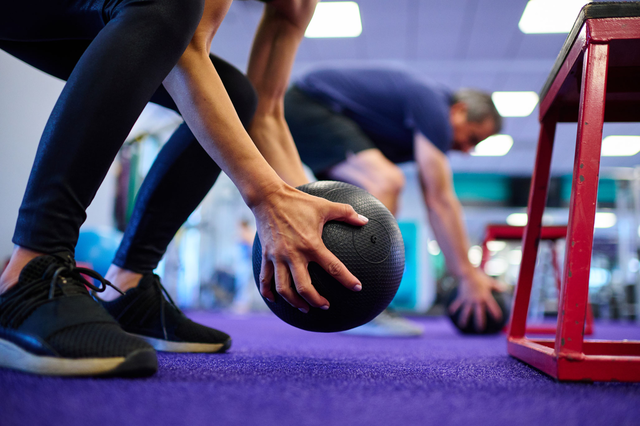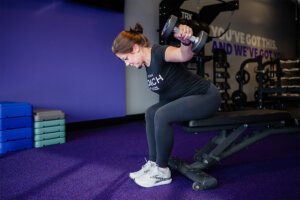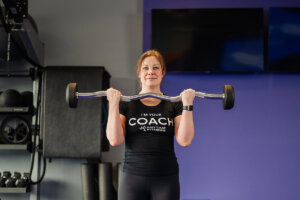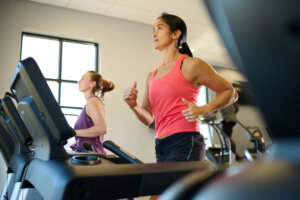There’s a lot of conflicting info in the fitness world around the best way to structure your workout plan each week. Is it best to work all your muscles at one time or should you “split” your workouts into lower and upper body sections? Some people even take it a step further and break down their strength training sessions into legs, shoulders and arms, and back and chest days because they feel that builds the most muscle mass over time. But for other people, that approach is too overwhelming, so they default to working everything at once. So, the question is: are split workouts or full body workouts better? And the truth is: it depends. *Cue eye roll*
Okay, but the truth is, it really does depend! The workout routine that is best for you will be based on the goals you’re trying to accomplish in the gym—that’s a no-brainer. If you’re looking to build strength and muscle mass, then splitting up your workouts to focus on certain muscle groups is the best route to take. Otherwise, if you’re looking to get in shape while you build muscle and burn fat, then full body workouts may be for you! Read on for a few other reasons why we love total body workouts.
Benefits of Full Body Workout Routines
Full body workouts are amazing because they promote balance, they burn a ton of calories in a short amount of time, and they also accelerate results because you get to work multiple muscle groups at one time with compound exercises.
They Promote Muscle Balance
Because you’re working out all your muscles in one session, you don’t need to worry about things like giving equal attention to each muscle or muscle group as you would in split workouts every week. Plus, you’ll often see compound exercises, which are exercises that work several muscles at the same time such as squats, bench press, and push-ups. Win!
They Burn More Calories
Like we just mentioned, total body workouts involve compound exercises, which means more muscles are working at once. You can probably guess where we’re going next, but if not: the more muscles working, the more energy you’re expending, which means you’re burning more fat and calories! Research studies back this up, too. And who wouldn’t want to burn an extra calorie or two?
They Are Less of a Time Commitment
This may seem slightly contradictory… but hear us out. Not everyone has time to fit 4-5 strength training workouts into their schedule each week—and that’s OK! But if you commit to the split approach and only make it to the gym twice in a week, then you’re skipping over at least an entire muscle group, whereas had you done two full body workouts, then you would have worked each muscle group twice. Make sense? Plus, focusing a few workouts a week on strength training is good, but it’s also important to set aside time for cardio, flexibility, and mobility exercises, too!
This workout will cover multiple bases at once, because there are strength-training exercises as well as exercises that focus on endurance included in the circuit. We are all about getting more bang for your buck when it comes to investing time and energy into feeling your best. By blending high-intensity exercises such as burpees with compound strength-training exercises like the renegade row, you’ll check both of those boxes off your to-do list. Look at you go!
Sounds pretty great, right? One thing to watch out for is the potential for overtraining if you are only doing this one workout style and not giving yourself time to recover fully. The best thing you can do to avoid this is to switch up your training routine so that your muscles are always guessing what’s next. It’s also important to give yourself a day of rest or active recovery so you can restore your tissues and energy levels to head into your next workout at full strength. This way, you’re certain to keep making progress towards your goals. What is active recovery, and how do you do it? We’ve got you covered with all the details at the end of this workout.
Ready to get rockin’ and rollin’? Let’s do this!
Full Body Workout Routine
Equipment needed: kettlebell, dumbbells, medicine ball/slam ball, battle ropes
Get ready for the best full body workout that will build muscle and burn fat all at the same time! Circuit training has been proven to be one of the most effective ways to increase heart rate, burn fat and calories, while still increasing muscle mass. For that reason, this workout will be in circuits!
This workout allows you to turn up or down the intensity with the amount of weight you use. For beginners or those who are just starting out, use light weights or consider completing each exercise without weights. If you’re looking for a challenge, use heavy weights—but not too heavy that your form is compromised.
We did mention that this was a circuit workout, so yes, you will be completing four short mini circuits. You’ll do some unilateral exercises (single-leg or single-arm, like half-kneeling overhead press) as well as compound exercises that engage many muscle groups. You will complete one set of each exercise one time through, taking minimal rest in between stations, and you’ll finish the designated number of rounds for each circuit.
With circuit training, the goal is to rest as little as possible in between stations to keep the intensity up, although it will differ for each person. If you can, aim for your rest period to be 20-30 seconds or less in between stations, and then rest 60-90 seconds again after each round. These short rest periods will allow your heart rate to stay up while refueling your muscles. Plus, it acts as a sneaky form of cardio!
Note: while you are completing back-to-back exercises, it’s important to remember that it is not a race. To get the most out of this workout (and prevent an injury), complete each exercise with control and proper form, while still reaching high intensity.
Let’s do it, AF Family!
Warm Up
Foam Roll Quads (:60 seconds each side)
- Lie face down with a roller under lower thigh just above your knee supporting your weight on your hands & toes with your arms straight.
- Press away, lowering yourself down, raising your feet and roll up along the front of your thigh from your knee to mid-thigh.
- Pull back, returning to a straight arm position, rolling down to the top of your knee again.

Overhead Squats (10 reps)
- Stand upright with your arms extended overhead and your feet shoulder-width apart.
- Lower yourself toward the floor, bending at the hips and knees, keeping your arms overhead.
- Press through your feet to return to the start position, keeping your back neutral/flat and your arms overhead throughout.
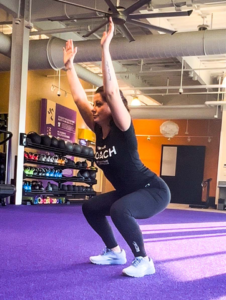
Plank Hold (:60 seconds)
- Lie face down on the floor with your legs straight and arms tucked in by your sides.
- Raise yourself off the floor, resting on your toes and forearms. Try to maintain your spine in a straight line and keep your back neutral/flat.
- Hold for a minute!
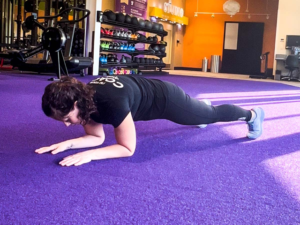
Circuit A (repeat 4x)
Goblet Clean (10 reps)
1. Stand with your feet shoulder-width apart with the kettlebell set on the floor between your feet.
2. Hinge at your hips, allowing your knees to bend so you can reach down to grasp the kettlebell handle with both hands.
3. Engage your core as you explosively extend your hips, straighten your legs, and squeeze your glutes as you begin drawing the kettlebell up toward your chin.
TIP: Keep your hands close to your body throughout the lift, as though you were zipping up a jacket.
4. Keep the kettlebell close to your front as you guide it up, adjusting your hand position to catch it at chest height.
5. Reverse the movement to return to the start position.
Additional information: if you don’t have a kettlebell on hand, you can substitute for a dumbbell.
Renegade Rows (10 reps each side)
1. Start in the top position of a push-up with your hands on the dumbbells.
2. Engage your core as you raise one dumbbell up to your shoulder, bending at the elbow.
3. Lower this dumbbell to the ground complete the reps on that side.
4. As you switch hands, feel strong and stable in your plank and keep your hips steady.
Feel free to lower your knees to the ground to complete this exercise from a supported plank position.
Half Kneeling Single-Arm Overhead Press (10 reps each side)
1. Start in the low lunge position.
2. Rack the kettlebell or dumbbell to your shoulder.
3. Keep your torso and glutes engaged as you press the weight overhead.
4. Return the weight to the starting position and complete all the reps on this side before switching sides.
Circuit B (repeat 3x)
Bicep Curl to Overhead Press (15 reps)
1. Hold a barbell or two dumbbells with your hands shoulder-width apart and your arms straight, wrists facing out.
2. Raise the barbell or dumbbells up to shoulder height by bending at the elbows and flexing the front of your upper arms. Keep your elbows at your sides.
3. Press the barbell or dumbbells overhead, extending your arms fully.
4. Lower the weight first back to shoulder height, then reverse the curl motion to return back to the starting position.
Bent-Over Medicine Ball Slam (15 reps)
1. Hold a medicine ball at your chest, and then hinge into a deadlift position.
2. Release and slam the ball as hard as you can toward the floor.
3. Catch the ball as it bounces back to you.
4. Be explosive and remember to breathe!
Circuit C (repeat 3x)
Forearm Plank with Hip Drop (10 reps each side)
1. Get into a forearm plank position with feet hip-width apart.
2. Squeeze your core and rotate your torso and lower body so that your left hip is facing the floor. It’s OK if you don’t touch the ground but aim to get as close as possible. You should stay up on your toes.
3. Come back to a neutral position over your forearms and repeat the same exercise, just to the right now. That is two reps.
Additional information: to make this easier, place your feet shoulder-width apart for extra stability.
Squat Jumps (20 reps)
1. Place your feet shoulder-width apart and bend your knees to lower your glutes into a squat, being sure to keep your upper body upright as you press your heels into the ground.
2. At the bottom of the squat, jump straight up off the floor with as much power as you can. Use your arms to help gain momentum.
3. As soon as your feet land on the floor, drop right back into the squat position. Absorb the force of landing by bending your knees and engaging your leg and core muscles.
Circuit D (repeat 3x)
Side to Side Rope Slams (:30 seconds)
1. Hold one end of the rope in each hand.
2. Rapidly swing both arms out to one side at chest height, flipping both sides of the rope out.
3. Swing your arms back to the other side and chest height.
4. Continue to rapidly swing your arms to alternating sides. Remember to breathe!
Burpees (:30 seconds)
1. Start in a plank position.
2. Jump your feet in, bringing your knees to your chest while keeping your hands on the floor.
3. Come to an upright position and jump into the air, raising your arms overhead.
4. As you come down from the jump, bend your knees to absorb the landing and squat down to place your hands on the floor, near your feet.
5. Jump your feet back out into the starting plank position.
Cooldown
Way to go! After all of that hard work, you deserve a proper cooldown! It might be tempting to wrap it up and start your next part of your day right away but trust us when we say you’ll thank yourself later for putting in the time immediately after your workout to stretch, foam roll, or even walk on the treadmill for a few minutes. Whatever you choose, give yourself 5-7 minutes for a proper cooldown and make sure you allow your heart rate to return to resting. This is a great time to focus on restorative breathing. Here are our favorite cooldown routines to try! Check out these 7 Yoga-Inspired Stretches to Cool Down After Your Next Workout or this guide to Foam Rolling Your Upper and Lower Body.
Fuel Your Full Body Workout with Proper Nutrition
Full body routines demand quite a bit of energy, but what you’ll get is more energy later in return for all your effort during the workout. Going into this kind of training without being properly fueled is a risk you may not want to take—avoid potential pitfalls like feeling sluggish or getting dizzy by giving proper attention to your nutrition. It’s best to eat a meal or pre-workout snack at least 45 minutes before you plan to hit the gym. In the market for some ideas on what to eat? We’ve got your back! Here’s a list of Coach-Approved Pre-Workout Snacks.
What separates full body workouts from the rest? They are physically demanding because of the compound exercises and their functional nature—often you need to use balance, strength, coordination and power all at the same time while also using many different muscle groups. Not only will you want to head into your workout with your nutrition game on point (we’re talking healthy carbs and lean protein) it’s a good idea to get these in after you exercise as well, within 90 minutes of finishing. Nutrition is key to giving your body what it needs to repair and recover, until next time! You didn’t think we’d have pre-workout options without also giving you ideas for after, did you? We didn’t think so—have at it, team! Here are our Coach-Approved Post-Workout Snack Ideas.
Restore Your Body with Active Recovery
Your cooldown happens right after you complete your workout, but your recovery doesn’t stop there. A cooldown lasts under 10 minutes, but recovery can take 24-48 hours or more. This is the time that your body takes in order to repair and rebuild the tissues you used during your workout, including muscles but also bones and connective tissues, even your brain and central nervous system need recovery time!
Here are the key ingredients to a successful recovery phase:
- Proper hydration: it’s best to drink half your weight in ounces of water per day, plus an extra 8 ounces for every 30 minutes you worked out
- Get your zzz’s: 7-9 hours is the sweet spot, but everyone is different!
- Movement: getting up and going will help you recover faster than if you were to lay down or sit, as sometimes people tend to do if they are experiencing soreness. Rest is important but you’ll want to keep moving, because it helps reduce inflammation and relieve tightness and stiffness.
Taking these steps between full body workouts will help you get the most out of your time spent exercising without risking overtraining. We’ll see you in the gym!
